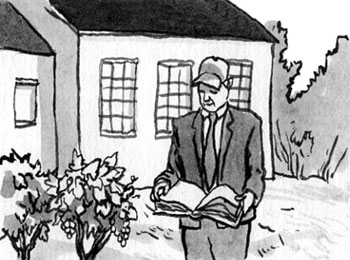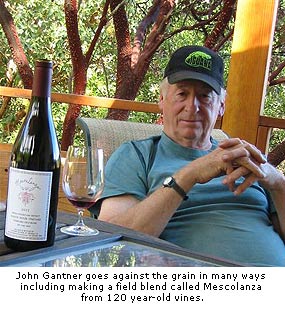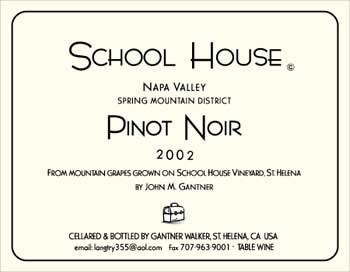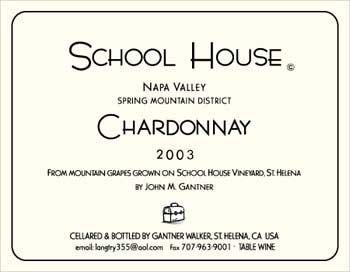

On Napa’s Spring Mountain, where Cab is King, John M. Gantner teaches lessons in old school Pinot Noir and Chardonnay.
Spring Mountain District ~ Napa Valley (AVA)
Old School Pinot Noir and Chardonnay: An interview with John M. Gantner
"I’m doing it (making Pinot Noir and Chardonnay) pretty much how I want to do it, and doing it in the old style. York Creek and Philip Togni make a very fine Cab, but I don’t like Cab. It’s a personal thing."
by
Alan Goldfarb
October 22, 2006
Alan Goldfarb (AG): Do people confuse School House with Liberty School?
 John M. Gantner (JMG): Every once in a while. The real problem is the telephone number. Caymus is 4204 and we’re 4240. … But if I tell people it’s School House, they say, “oh yeah, Liberty School.”
John M. Gantner (JMG): Every once in a while. The real problem is the telephone number. Caymus is 4204 and we’re 4240. … But if I tell people it’s School House, they say, “oh yeah, Liberty School.”
AG: Your father started up on Spring Mountain in 1940. Who else was up there then?
JMG: Herman Hummel had York Creek (now owned by Fritz Maytag) and then there was the property called La Perla that Jerry Draper had. Karl Beringer down the road had 16 acres. There was Conradi (now Keenan) and Matuzzi, and then Yverdon (now Terra Valentine).
AG: What is it about Spring Mountain that’s conducive to grape growing?
JMG: I really can’t answer that definitively. We have all these benches and all these different soils. In my vineyard there are loams, clay, gravel, just in 15 acres.
I don’t have a clue what the cohesive factor is though; what makes the terroir. But when I taste wines from York Creek and ours, there are definite bonding factors. There’s a mineral-y taste, but I don’t have enough knowledge and skill to tell you definitively. I can give you a lot of bullshit, but I won’t. I’ll be very humble.
It’s a volcanic soil that has a little bit of serpentine (rock) that is not good and has a whole lot of mercury and cinnabar (mercury ore) that is not good for vineyards, and makes the soil very red. This is not on my place, but it’s near us.
 AG: Why do you grow Pinot Noir when hardly any of your neighbors do?
AG: Why do you grow Pinot Noir when hardly any of your neighbors do?
JMG: Ritchie Creek Vineyards makes a Pinot from 2 or 3 acres. (Gantner has 6 or 7 acres of Pinot.)
AG: You obviously think Pinot does well there?
JMG: Well, my dad did. I disagreed with him on many points, but not Pinot.
AG: Describe your Pinot.
JMG: We don’t make a high alcohol wine. It averages about 12.5 percent…It’s very feminine and approachable, in the Burgundian style. It’s not a heavy wine and it’s not dark.
AG: Do you irrigate?
JMG: We’re not irrigated. We (and Stony Hill) are the only vineyards on the mountain that are not irrigated. We never have. We make a fine wine without irrigating and we get a half-ton an acre. (The field blend usually comes in at 1½ tons.)
AG: The budwood for your Pinot was from Domaine de la Romanée-Conti and was planted in 1953, I believe? And then your dad produced his first Pinot in ‘57?
JMG: Yes, my father got it from John Daniels, (the owner of Inglenook). They were old college friends.
AG: How much of an influence does that DRC budwood have?
JMG: It’s very important indeed, 50 percent at least. We’re trying to make a French Burgundy style.
AG: I understand you still have some of the vineyard's original vines from 120 years ago. Tell us about those.
JMG: It goes into the Mescolanza, which is 10 percent Carignane, 20 Petit Sirah, and 70 percent Zinfandel. They all have a few old vines, but I’m losing a few every year. They’re all on St. George (rootstock), but since 1990 I’ve been using 110R. The average age (of the vines) is 30-to-40 years.
AG: Also, Fred McCrea gave your father budwood from his Chardonnay in the late 1960s?
JMG: Yes, it was the Wente clone, which produces small berries and makes a highly concentrated syrup. That adds a lot to it. It’s planted on volcanic tuff (or tufa, a porous stone) so it’s very well drained.
AG: How does it compare to Stony Hill's Chardonnay?
JMG: I like mine better and that’s with complete objectivity (laughs). … We get more concentrated juice.
AG: What defines the style of your Chardonnay?
JMG: It’s highly mineral and we don’t ferment in oak. I cannot bear oaky Chardonnays. Ours only go into old (5 to 6 year-old) barrels for six months.
AG: Why not make a Cabernet like all your neighbors? Wouldn’t it be tempting?
JMG: I don’t because everyone else is doing it. It’s the same reason that I’m not irrigating. Everyone else is. I’m doing it pretty much how I want to do it, and doing it in the old style. York Creek and Philip Togni make a very fine Cab, but I don’t like Cab. It’s a personal thing.
~ Alan Goldfarb, Regional Correspondent – Napa Valley
To comment on Alan Goldfarb’s writings and thoughts, contact him at a.goldfarb@appellationamerica.com
 John M. Gantner (JMG): Every once in a while. The real problem is the telephone number. Caymus is 4204 and we’re 4240. … But if I tell people it’s School House, they say, “oh yeah, Liberty School.”
John M. Gantner (JMG): Every once in a while. The real problem is the telephone number. Caymus is 4204 and we’re 4240. … But if I tell people it’s School House, they say, “oh yeah, Liberty School.”AG: Your father started up on Spring Mountain in 1940. Who else was up there then?
JMG: Herman Hummel had York Creek (now owned by Fritz Maytag) and then there was the property called La Perla that Jerry Draper had. Karl Beringer down the road had 16 acres. There was Conradi (now Keenan) and Matuzzi, and then Yverdon (now Terra Valentine).
AG: What is it about Spring Mountain that’s conducive to grape growing?
JMG: I really can’t answer that definitively. We have all these benches and all these different soils. In my vineyard there are loams, clay, gravel, just in 15 acres.
I don’t have a clue what the cohesive factor is though; what makes the terroir. But when I taste wines from York Creek and ours, there are definite bonding factors. There’s a mineral-y taste, but I don’t have enough knowledge and skill to tell you definitively. I can give you a lot of bullshit, but I won’t. I’ll be very humble.
It’s a volcanic soil that has a little bit of serpentine (rock) that is not good and has a whole lot of mercury and cinnabar (mercury ore) that is not good for vineyards, and makes the soil very red. This is not on my place, but it’s near us.
 AG: Why do you grow Pinot Noir when hardly any of your neighbors do?
AG: Why do you grow Pinot Noir when hardly any of your neighbors do?
JMG: Ritchie Creek Vineyards makes a Pinot from 2 or 3 acres. (Gantner has 6 or 7 acres of Pinot.)
AG: You obviously think Pinot does well there?
JMG: Well, my dad did. I disagreed with him on many points, but not Pinot.
AG: Describe your Pinot.
JMG: We don’t make a high alcohol wine. It averages about 12.5 percent…It’s very feminine and approachable, in the Burgundian style. It’s not a heavy wine and it’s not dark.
AG: Do you irrigate?
JMG: We’re not irrigated. We (and Stony Hill) are the only vineyards on the mountain that are not irrigated. We never have. We make a fine wine without irrigating and we get a half-ton an acre. (The field blend usually comes in at 1½ tons.)
AG: The budwood for your Pinot was from Domaine de la Romanée-Conti and was planted in 1953, I believe? And then your dad produced his first Pinot in ‘57?
JMG: Yes, my father got it from John Daniels, (the owner of Inglenook). They were old college friends.
AG: How much of an influence does that DRC budwood have?
JMG: It’s very important indeed, 50 percent at least. We’re trying to make a French Burgundy style.
AG: I understand you still have some of the vineyard's original vines from 120 years ago. Tell us about those.
JMG: It goes into the Mescolanza, which is 10 percent Carignane, 20 Petit Sirah, and 70 percent Zinfandel. They all have a few old vines, but I’m losing a few every year. They’re all on St. George (rootstock), but since 1990 I’ve been using 110R. The average age (of the vines) is 30-to-40 years.

AG: Also, Fred McCrea gave your father budwood from his Chardonnay in the late 1960s?
JMG: Yes, it was the Wente clone, which produces small berries and makes a highly concentrated syrup. That adds a lot to it. It’s planted on volcanic tuff (or tufa, a porous stone) so it’s very well drained.
AG: How does it compare to Stony Hill's Chardonnay?
JMG: I like mine better and that’s with complete objectivity (laughs). … We get more concentrated juice.
AG: What defines the style of your Chardonnay?
JMG: It’s highly mineral and we don’t ferment in oak. I cannot bear oaky Chardonnays. Ours only go into old (5 to 6 year-old) barrels for six months.
AG: Why not make a Cabernet like all your neighbors? Wouldn’t it be tempting?
JMG: I don’t because everyone else is doing it. It’s the same reason that I’m not irrigating. Everyone else is. I’m doing it pretty much how I want to do it, and doing it in the old style. York Creek and Philip Togni make a very fine Cab, but I don’t like Cab. It’s a personal thing.
~ Alan Goldfarb, Regional Correspondent – Napa Valley
To comment on Alan Goldfarb’s writings and thoughts, contact him at a.goldfarb@appellationamerica.com












